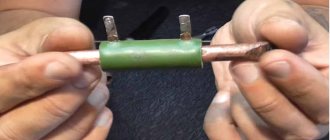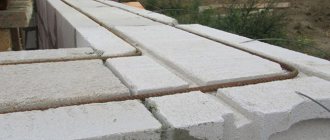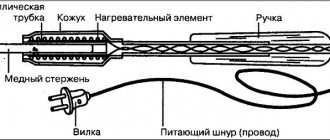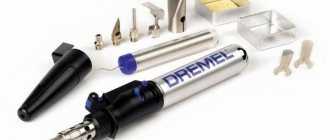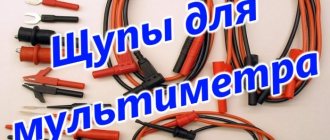How to recalculate coil turns and capacitances for your sensor
Still, it got boiling, so I decided to write a short article - a manual for recalculating turns.
So, we have verified data for an “ideal” sensor, say, from this site =) We need to obtain winding data for a sensor of the same type (this is important!), but of a different size and/or at a different frequency. You can spend a long time poking around the forums and not always waiting for the right answer. That’s if you’re not at all alyo.. Or you can calculate it yourself, fortunately for this you only need a calculator, which you a priori have, half an hour (at most!) of time and an IQ above zero. It is assumed that you know how to count and generally completed elementary school =) To recalculate, you need the initial data of the “ideal” sensor , namely: diameter (for round, for other shapes you can guess on your own) in centimeters, operating frequency in Hz or kHz, number of turns of TX and RX windings in pieces. The desired size of your sensor (in centimeters) and the desired operating frequency in Hz or kHz will also not interfere. We'll count the turns, and I'll tell you about the containers later.
First, an introductory one. I ask those who know the question not to comment, explanations are for dummies. I quote myself:
If you think about it, the “strength” of the signal from the target is determined by its energy, which, with a constant irradiating field, is always conditionally the same. The signal from the target, like an EM wave from a point source (we assume that the interesting target is small), propagates approximately equally in all directions. Accordingly, with the same distance of the coil to the target (other things being equal), the determining parameter of the receiving coil, ensuring maximum “capture” of the response energy, will be the area of the receiving coil. The larger the area, the more energy, the “stronger” the response. In the coil, the field energy is converted into EMF (voltage), the level of which depends (at constant energy) on the number of turns. On the other hand, we do not need too high a response voltage, because the metal detector is a very sensitive device. And as the number of turns increases, the voltage induced by external unnecessary signals, which interferes, also increases.
Conclusion: for each standard size of the receiving coil there is an optimal number of turns, below which the sensitivity drops, and above which noise begins to increase, but much slower than the sensitivity drops when “sick” (because the sources of this external noise are much further away than the response we need) . Therefore, if you want to estimate your sensor, take any verified data (for example, mine) of the coils, count the areas and, in proportion to the square root of their ratio, change the number of turns, making a margin of plus 1 to 5 percent (approximately) - then you will get anywhere near the optimum. The principle is simple: the larger the sensor area, the fewer turns.
However, recalculation by area is correct for approximately the same frequencies, plus or minus 1 kilohertz conventionally. If the frequencies are very different, then after recalculation by area it is necessary to make a correction for the frequency, take the frequency ratio and extract the 3rd root from it. The resulting number will be the coefficient by which the number of turns obtained by recalculation by area must be divided, according to the principle: higher frequency - fewer turns.
Example of recalculation of sensor turns
Let's say there is a description of an ideal sensor. With a diameter of 28 cm, at 7 kHz, the number of RX turns is 215. But we want 15 cm and at 15 kHz.
That's it, for the desired DD15 sensor at a frequency of 15 kHz, the RX circuit data is as follows: 330 turns of 0.18 wire (any from 0.15 to 0.22 mm), capacitance 33 nF + 3600 pF (in parallel). For TX it is calculated by analogy.
Let me remind you that this is an approximate (but giving well repeatable results) calculation based on typical dependencies and correct initial data. It’s better to start recalculation with TX, because you can use Quasar to look at the resulting resonant frequency and, if necessary, make corrections.
For the especially lazy, I wrote a counting rhyme in Excel, use it! DOWNLOAD XLS FILE
If anyone finds errors, please write through the feedback form, thank you!
Source
Purpose and principle of operation
In order to assemble your own metal detector, you only need to know the operating principle of such devices.
Devices designed to search for gold, silver, and platinum operate on the principle of an electromagnetic probe. The main difference of such a device is that a metal detector for searching for gold does not respond to ordinary, so-called “ferrous” metals.
A similar device consists of the following elements:
- Transmitter coil. Used to inject an electromagnetic field (EMF) into the ground. EMF interacts with metal based on its electrical conductivity. It is electrical conductivity that contributes to the interaction of the magnetic field.
- Receiver coil. It is used to obtain a reverse magnetic field from a metal that has entered the field of electromagnetic radiation from a transmitter coil.
- Control block. Is the most important detail. Using the block, the entire circuit is powered, a frequency signal is created, the signal frequency is processed, and a response is created to an object that appears in the zone. The block is also used to configure general oscillation frequency parameters. This is necessary to change the penetrating ability and size of the impact zone.
The metal detector works according to the following principle:
- The unit powers the transmitter coil, on which a magnetic field (MF) of a certain magnitude is created. The magnetic field passes through the soil.
- When metal objects are in the soil, the magnetic field interacts with them due to the electrical conductivity inherent in metals.
- The surface of non-magnetizable metals is exposed to a magnetic field, which leads to the formation of vortex magnetic fluxes.
- These currents affect the magnetic field.
- The receiver coil reacts to the impact. It also creates a magnetic field, but due to pulsed vortices it is significantly reduced, which leads to modulation of the signal for the control unit.
Here it is worth considering the main difference between a metal detector for gold. This metal is not magnetizable. This means it does not have its own magnetic field. If it were, the detector would determine the difference between the frequency of the transmitted field and the detected one. Thus, the device can sift out “ferrous” metals from precious ones with great accuracy.
The operation of any metal detector depends on several design nuances. They are as follows:
- Characteristics of sensitivity and selectivity. The first characteristic greatly influences the search result. Gold does not always come in the form of jewelry or other items. Very often this metal is found in the ground in the form of small particles or stones. To search for such elements, the device must operate in the range of 15 kHz and above. The selectivity of the device is also very important. This parameter allows you to filter out all materials that have the property of magnetization. Also, the device must determine copper, aluminum, bronze by the characteristics of electrical conductivity in a humid environment. If the nugget is located in soil with a large amount of iron ore, it is the selectivity function that will help determine the change in the magnitude of MP fluctuations.
- Penetration ability. This parameter allows you to increase the penetration of magnetic radiation under the soil surface. This characteristic largely depends on the type of soil, its condition and humidity. The parameter of the transmitter coil is responsible for this value. The wider the diameter of this element, and the greater the number of turns of wire on it, the more powerful the magnetic field created will be. But the magnitude of the field is not a parameter for the exact impact in depth. A significant amount of power can be lost as the zone expands. The main thing here is to find the golden mean between the amount of penetration and the width of the impact zone.
- Impact area. This characteristic allows you to reduce or expand the impact area. If the device has a wide coverage capability, then this significantly reduces the possibility of penetration into the ground. If the zone is narrow, then the penetration power is higher and the accuracy is greater. The coverage area can be narrowed or expanded. This is especially necessary when the device has reacted to metal, but it is quite difficult to accurately determine its location. As the impact zone narrows, the power increases, thereby allowing you to narrow the search range and more accurately determine the location.
- Discrimination. A function that determines the composition of the soil. Typically, the most modern devices are equipped with this capability. Such metal detectors can determine the presence of small nuggets and gold sand by the composition of the soil. This function helps the searcher, even at the very beginning of work, to determine the areas most saturated with metals.
The principle of operation and the main characteristics described earlier are, for the most part, inherent only in professional metal detectors. It will be quite difficult to achieve similar properties in a self-assembled device. It is very easy to assemble a homemade metal detector, and its performance can be improved by testing coils of different diameters. Next, detailed instructions will be given on how to independently construct a metal detector for gold.
P O P U L A R N O E:
Repair.
Furniture arrangement. We arm ourselves with a pen, sheets of paper and start planning... We draw a room plan, furniture, imagine how everything will be... All this is not convenient, and it’s problematic to imagine, but... the free Sweet Home 3D program will help us make it easier to plan our future room !
VIRTUAL PRINTER
If you don’t have a printer, but need to print something, you can use a free program - PDFCreator. When printing a document, select PDFCreator in the printer selection window. The document will be converted to PDF format and saved to your computer.
And sometimes you don’t need to print the file, but simply convert it to PDF format. This format is not only easy to read, but also safe for copying and subsequent editing. Let's take a closer look at the free document converter - PDFCreator.
Read more…
Rusang Russian -English speaking phrasebook. Son of incest Kortana and VerfoxICQ. Read more…
your comment
SEARCH from GOOGLE:
Homemade coil for a pulse metal detector
Looking ahead, I’ll say right away that I coped with the task. As a result, I got this sensor:
By the way, the resulting ring coil is perfect not only for Clone, but also for almost any other impulse generator (Koschei, Tracker, Pirate).
Next, I will tell you how to make a search coil for a metal detector with your own hands, spending less than 500 rubles on it.
I will tell you in great detail, since the devil is often in the details. Moreover, there are a dime a dozen short stories about making reels on the internet (like, take this, then cut it off, wrap it, glue it and you’re done!) But you start doing it yourself and it turns out that the most important things were mentioned in passing, and some things were completely forgotten to say . And it turns out that everything is more complicated than it seemed at the very beginning.
This won't happen here. Ready? Go!
Pros and cons of a homemade metal detector
Homemade metal detectors have both advantages and disadvantages. The device is inexpensive and can be adapted to the user's requirements. It also combines the following advantages:
- Using primitive detection technology, which is convenient for novice users.
- Possibility of producing a detector with any shape, configuration and external design.
- Getting positive emotions from assembling and configuring the device.
Homemade metal detectors are low cost.
The disadvantages of a hand-assembled metal detector include:
- Intensive battery consumption.
- No discrimination option.
- Limited sensitivity.
Idea
The easiest design for me to make it myself seemed to be this: take a disk made of sheet material thick
4-6 mm. The diameter of this disk is determined by the diameter of the future winding (in my case it should be 21 cm).
Then we glue two disks of slightly larger diameter to this pancake on both sides to make a bobbin for winding wire. Those. such a coil greatly increased in diameter, but flattened in height.
For clarity, I’ll try to depict this in a drawing:
I hope the main idea is clear. Just three disks glued together over the entire area.
Material selection
I planned to use plexiglass as the material. It is perfectly processed and glued with dichloroethane. But, unfortunately, I couldn’t find it for free.
All sorts of collective farm materials such as plywood, cardboard, bucket lids, etc. I immediately discarded them as unsuitable. I wanted something strong, durable and preferably waterproof.
And then my gaze turned to fiberglass.
It's no secret that fiberglass (or glass mat, fiberglass) is used to make whatever your heart desires. Even motor boats and car bumpers. The fabric is impregnated with epoxy resin, given the desired shape and left until completely cured. The result is a durable, water-resistant, easy-to-handle material. And this is exactly what we need.
So, we need to make three pancakes and ears for attaching the barbell.
Housing for metal detector
After assembling a metal detector or other radio circuits, the question arises: what kind of housing to come up with for it and where to get it. I found a simple and inexpensive solution to this problem. As a housing, I will use the box for the starter machine and place the Pirate metal detector in it. Below I will provide detailed instructions and a description of how to make a housing for a metal detector.
So, to make a housing for a metal detector, you need to buy, as I said above, boxes and automatic light starters, it is not expensive, around 25-50 rubles.
Since I will be making a housing for the Pirate metal detector, I need to install two variable resistors on it, a power switch and a block for connecting the coil and power source. First, I’ll install the resistors; to do this, we attach them to the body with twisters and mark the marks for the holes with a marker; I decided to install them on the top part.
Then we take a drill to the diameter of the resistor handles and drill holes. Plastic drills very well, so if you don't have the right drill bit, you can use a circular motion to drill out the holes!
Assembly into one piece
Ear mounting
I cut the grooves using a jigsaw. Naturally, I overdid it a little in one place:
To make the ears fit well, I made a small bevel on the edges of the cuts:
Now we had to decide which option is better? Ears can be placed in different ways.
Industrially produced reels are often made according to the right-hand version, but I prefer the left-handed one. In general, I often make leftist decisions.
In theory, the right method is better balanced, because The rod mount is closer to the center of gravity. But it is far from a fact that after lightening the coil, its center of gravity will not shift in one direction or another.
The left mounting method looks more visually pleasing (IMHO), and in this case the total length of the metal detector when folded will be a couple of centimeters shorter. For someone who plans to carry the device in a backpack, this may be important.
In general, I made my choice and started gluing. He generously smeared it with bauxite, securely fixed it in the desired position and left it to harden:
After hardening, I sanded off everything sticking out from the back side with sandpaper:
Cable entry
Then, using a round file, I prepared grooves for the conductors, inserted the connecting cable through the hole and glued it tightly:
To prevent strong kinks, the cable at the entry point needed to be somehow reinforced. For these purposes, I used this little rubber thing that I got from God knows where:
Of course, if I had a normal sealed lead-in, it would be much better, but. and that will do.
All that remained was to glue the third pancake (the bottom).
Finishing the frame
To glue the third pancake it took several milliliters of bauxite and a couple of hours for everything to set. Here's the result:
Thus, I received a rigid and durable frame, fully prepared for winding the wire.
Winding sealing
An enameled copper wire with a diameter of 0.71 mm was used as a winding wire. After winding 27 turns, the sensor became heavier by another 65 grams:
Now the winding had to be caulked somehow. As putty I used a mixture of epoxy resin and finely chopped fiberglass (I learned about this super recipe from this article).
In short, I cut some fiberglass:
and mixed it thoroughly with bauxite with the addition of ballpoint pen paste. The result was a viscous substance similar to wet hair. With this composition you can cover any cracks without problems:
Pieces of fiberglass give the putty the necessary viscosity, and after hardening, provide increased strength to the adhesive joint.
So that the mixture is properly compacted, and the resin saturates the turns of the wire, I wrap it all with electrical tape tightly:
The electrical tape must be green or, at worst, blue.
After everything froze thoroughly, I wondered how strong the structure turned out to be. It turned out that the reel could easily support my weight (about 80 kg).
In fact, we don’t need such a heavy-duty reel; its weight is much more important. Too much mass of the sensor will definitely cause shoulder pain, especially if you plan to conduct a long search.
What types of metal detectors are there?
Depending on the class, metal detectors are divided into the following groups:
- Initial models.
- Average level.
- For professionals.
The first category includes inexpensive devices that can be used to search for small metal objects.
Metal detectors come in different types.
The middle level is adapted for domestic use and can find metal products at a depth of up to 0.5 m.
Professional models are quite expensive, but they perform deep scanning of soil layers. They check all types of soil and search for the smallest objects. The models support different operating modes, but require operating skills.
Depending on the principle of operation, metal detectors are:
- Impulse.
- Phase sensitive.
- Parametric.
- Induction.
Main parameters
All metal detectors have the following technical parameters:
- Penetrating ability. The parameter determines the permissible depth to which the EMF passes.
- The size of the search zone. The characteristic indicates an imaginary area in the soil where objects are identified.
- Sensitivity. The more sensitive the device, the more small objects it can detect.
- Selectivity. The property makes it possible to distinguish individual types of metals.
- Resistant to interference. The parameter affects the ability not to respond to EMF from third-party sources, lightning discharges, power lines and vehicles.
- Discrimination or permissiveness. The presence of this option allows you to estimate the size and parameters of the found object based on the nature of the signal or visualization.
All metal detectors have penetrating ability.
Operating frequency
Depending on the frequency, metal detectors are divided into the following types:
- High frequency. Capable of operating in a frequency range up to several hundred kHz. With their help, you can search for gold and other precious metals using the discrimination option. But when examining wet or magnetic soil, the search accuracy decreases sharply.
- Mid-frequency. The operating frequency is limited to tens of kHz. Moreover, devices of this class are quite sensitive and can detect a signal at a depth of up to 1.5 m.
- Low frequency. Their range starts from hundreds of Hz and reaches several kHz. The equipment is suitable for deep work, easy to operate and efficient.
- Ultra-low frequency. Not used for amateur hikes due to high energy consumption and large dimensions. In addition, the signal is processed exclusively using software.
Search method
There are about 10 ways to search for metals using EMF. But in the manufacture of homemade devices the following technologies are used:
- Pulse. The functions of transmitter and receiver are performed by a single part. It reacts to the movement of the phases of the reflected signal. As the shift increases, the detector makes characteristic clicks. The closer the device is to the object, the more intense the sound.
- Double circuit. The devices are equipped with 2 symmetrical generators and 2 detectors. When faced with a metal object, the synchronization of the generating units is disrupted, which leads to the appearance of clicks.
- Parametric. Their design lacks receiving and transmitting parts, so the process of self-manufacturing is greatly simplified. The LC generator provokes the appearance of audio frequency EMF.
- Frequency. They produce signals at different frequencies. When an object with conductive properties is detected, the detector responds to changes in frequency parameters.
Pulse technology is used in the manufacture of the metal detector.
Without receiver (parametric devices)
Parametric models have a simplified design and operating principle. Object detection is carried out taking into account the impact of the object on the inductance and quality factor of the coil, and the parameters of the electromagnetic field do not play out the values.
Changing the properties of the EMF generator affects the frequency and amplitude of the oscillations. Metal detectors without a receiver are inexpensive, but their operation requires some skill.
With receiver and transmitter
Devices with a transmitter and receiver provide high efficiency in their frequency range, but they have a complex design and can only work with high-quality coils. Models with 1 element belong to the group of induction MDs. They are characterized by good repeatability and the ability to work with any placement of receivers relative to each other. But separating the primary signal from the secondary one is quite difficult.
Devices with a transmitter and receiver provide high efficiency.
Before click (with phase accumulation)
Phase-sensitive equipment is available in the following versions:
- with 1 coil;
- with 2 generators.
The first method involves spreading and holding impulses. As the phase shift increases, a click is heard in the headphones. Its intensity increases as it approaches the object. “Pirate” metal detectors have this operating principle.
The second option works on a similar principle, but using 2 generators that are located on each coil. As a result of the relationship, their EMFs are synchronized, so the devices operate in time.
Phase-sensitive models are of interest to people who like to look for jewelry on the beaches. Professionals set them up in such a way that they generate an alert exactly above the subject.
By squeak (by beat)
Electrical signal beats indicate a signal with a frequency that corresponds to the difference between the fundamental frequencies or multiple harmonics. There are 2 generating devices operating in the beating metal detector:
- working;
- supporting
Harmonica models have a complex design.
The oscillating circuit has a small EMF generator, which is isolated from external influences or equipped with a quartz stabilizer.
Harmonic models are more complex in design than pulse models, but they are suitable for testing all types of soil.
Facilitating
To reduce the weight of the coil, it was decided to cut out some sections of the structure:
This manipulation allowed me to lose 168 grams of excess weight. At the same time, the strength of the sensor has practically not decreased, as can be seen in this video:
Now, with hindsight, I understand how the coil could have been made a little lighter. To do this, it was necessary to make large holes in the middle pancake in advance (before gluing everything together). Something like this:
The voids inside the structure would have almost no effect on the strength, but would reduce the total mass by another 20-30 grams. Now, of course, it’s too late to rush around, but I’ll keep it in mind for the future.



